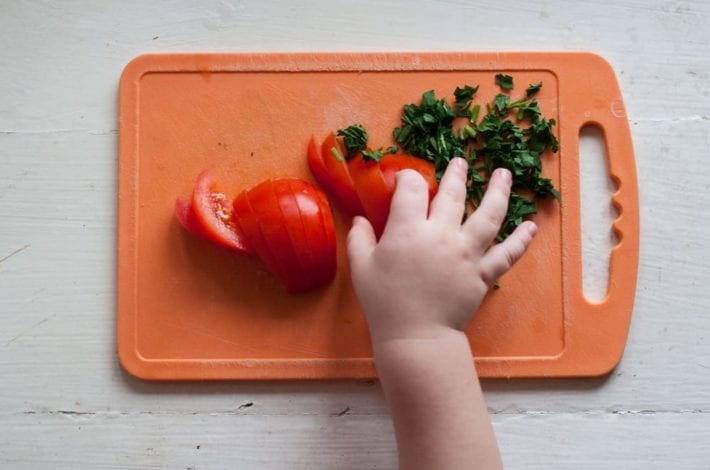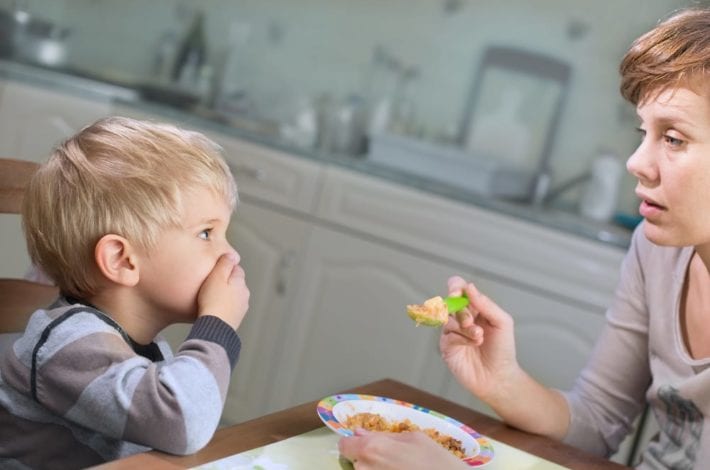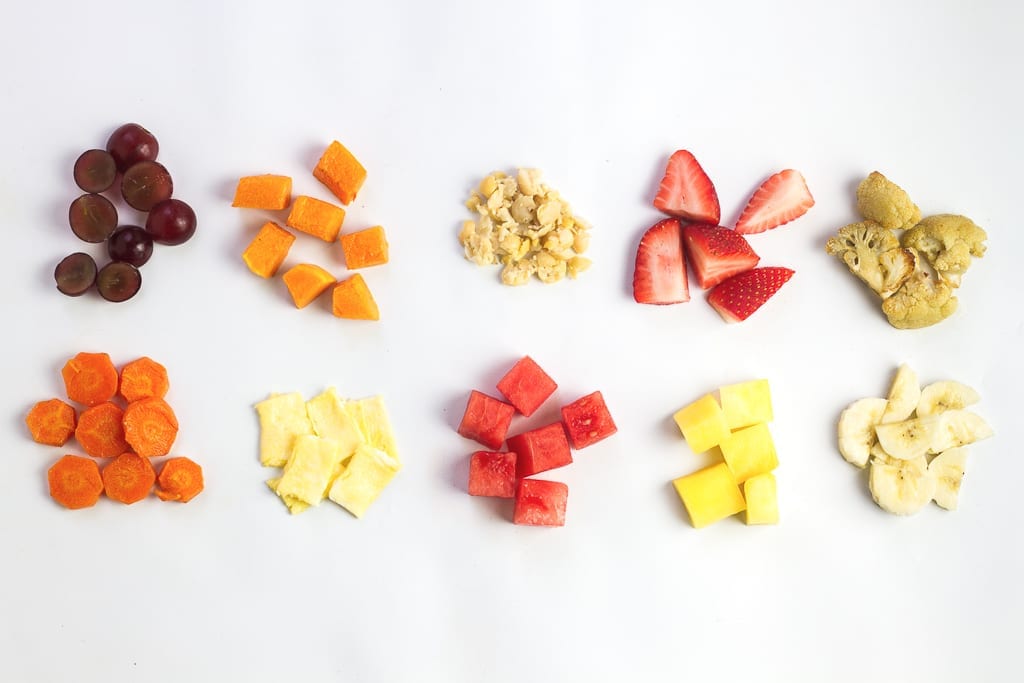

Are you wondering where to start when cutting foods for baby led weaning?
Many parents are unsure of what size or shape to cut food so that the pieces are big enough for their baby to pick up, but still small enough to be safe.
Find out how to prepare and cut foods so that they are the right size and texture for your baby to pick up and chew.
Baby led weaning choking worries
In a recent survey by best-selling author of baby recipes and nutrition, Annabel Karmel, parents revealed their main worries about baby led weaning.
95% of parents said that they had concerns about letting their babies feed themselves. One of the main concerns for almost 60% of those surveyed was a fear of their baby choking.
A huge 90% said they’d consider baby led weaning if they had simple advice to follow.
To help with this, here’s a simple guide on how to prepare, cook and cut foods for baby led weaning. We hope it makes you and baby feel more confident starting those first finger foods.
How to prepare foods for baby
When you start baby led weaning your baby might only have one or two teeth. Or a mouthful of gums, if their first pearly white hasn’t pushed through.
So one golden rule of preparing finger foods, is to make sure that they are soft enough for your little one to chew. In order for them to be able to feed themselves, it also helps if foods are cut so that they are the right size for them to be able to pick up and grab in their fist.
At all ages, foods should be soft enough that you can smash them with gentle pressure between your thumb and forefinger. Jenna Helwig
If you’re giving your baby fruit, choose soft, ripe fruits to begin with. And always cut off any peel or skins. Cook vegetables until they are nice and soft by boiling or steaming them. That way any bits your baby chews off will break up and dissolve easily.
There are all sorts of other finger foods you can introduce after fruit and veg. Cooked pasta, flaky fish, grains and soft meats (such as chicken) can all make it onto your menu.
Golden rules for preparing and serving food for baby led weaning:
Preparing baby’s food
- Wash your hands before preparing foods and keep surfaces clean.
- Cook foods until they are soft – for example vegetables and pasta.
- Cool cooked food and check it’s not too hot before giving it to your baby.
- Never add sugar or salt to your baby’s food or cooking water.
- Remove the skin or peel from fruits and vegetables.
- When you introduce small round foods (like grapes, cherries and cherry tomatoes) always cut them into small pieces. Cut them into quarters rather than halves.
- Avoid hard foods – such as raw carrots, raw apple and whole nuts. See our full list of foods to avoid completely below.
- Serve soft or ripe fruits.
- Use the ‘finger rule’ (see below) as a guide for cutting food into grabbable batons.
Serving Foods to Baby
- Stay close and supervise your baby while they are eating at all times.
- Ensure eating is always done in an upright position.
- If you have a mobile baby, make sure baby is sitting still while eating and not doing it on the run.
How to start baby led weaning?
When your baby is ready for baby led weaning, you can start by offering them soft fruits and vegetables. Cut foods in a way that baby can grasp and explore. Below is a guide of how to cut each food for each stage of weaning.
Keep up the same milk feeds when you start weaning. At the beginning it’s more about your baby exploring new tastes and textures. They’ll still get most of their energy and nutrition from milk feeds.
Make sure to follow the safety guidelines (above) for baby’s meals too.
If you’re looking for more guidance on baby led weaning, take a look at our related articles:
Baby Led Weaning Foods by Age
A guide of how to start baby led weaning, when you should start it along with a list of the ideal foods to offer at each age and stage.
Top 30 Baby Led Weaning First Foods
Here 30 first foods are listed in more detail along with ideas of how to prepare each one.
Offer new foods a few times, even if baby isn’t keen on them
Be patient and offer new foods several times. Let your baby touch, squish, lick and taste the foods.
If they wrinkle their noses and refuse them, let them try them again later.
It can take 10 tries or more for your baby to get used to new textures and flavours.
How to Cut Food for Baby Led Weaning by Stage
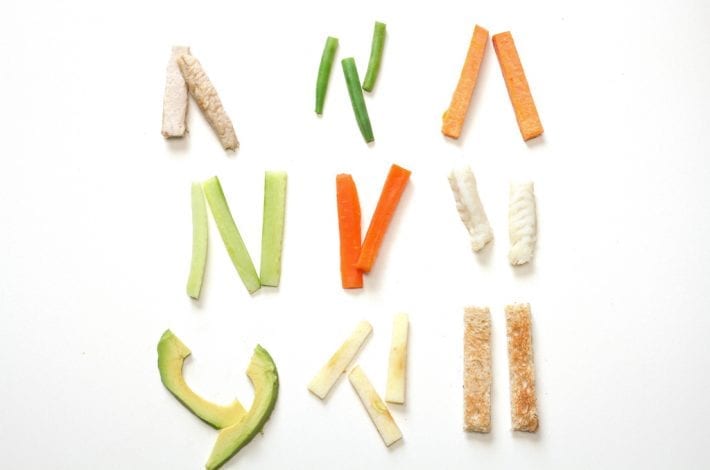

How to Cut First Foods for BLW at 6 Months
If you begin baby led weaning with baby from 6 months’ old, they won’t have developed a good pincer grip. (A pincer grip is the ability to hold an item with their thumb and forefinger).
Instead, baby will need food that they can grasp in their whole palm or fist.
For that reason, food batons can work very well for baby at this stage.
Cut food into strips which are long enough for baby to grasp with their hand, with a little bit left poking out of the top of their palm for them to gnaw on.


The Rule of ‘Finger’
A great rule of thumb when cutting finger foods for baby is the rule of ‘finger’.
Use your index finger as a guide for what size to cut food.
Finger food is food that’s cut up into pieces big enough for your baby to hold in their fist with a bit sticking out.
Pieces about the size of your own finger work well.(NHS)
This is a great rule of thumb (or, in this case finger) to follow. It lends itself to so many cooked vegetables, soft fruits, strips of soft fish or meat and bread or pancakes.
A great tool for chopping batons so that they’re ready to cook are food slicers like this one. That way they’re ready in batons to cook.

 Safe Slice Mandolin for Fruits and Vegetables
Safe Slice Mandolin for Fruits and Vegetables
30 different preset cuts for different thicknesses 1-8mm.
Amazon link: https://amzn.to/38nn576
But not every finger food you want to give your is the right shape or size to cut up into finger sized batons.
Here’s a list of some baby led weaning foods and how to cut and prepare them.


How to Cut Foods for BLW at 8-10 Months
Between 8-10 months your baby will have developed their pincer grip.
They will be able to pick up smaller chunks of food between their thumb and forefinger. At this stage you can cut up food into smaller pieces or chunks.
You’ll soon learn what sized chunks your baby can handle. They might still need larger pieces about an inch wide, or they might be able to pick up foods as small as boiled peas with their fingers.
Each baby develops at their own rate so if they need big chunks or to continue with batons for a while that’s completely fine.
When babies develop their pincer grasp start cutting foods into small pieces, about chickpea-sized. And for small round foods like chickpeas or blueberries, smash them lightly before serving. It’s great for babies at this age to practice their pincer grasp, but it’s A-OK to continue serving food in sticks like you did when he was younger. Jenna Helwig
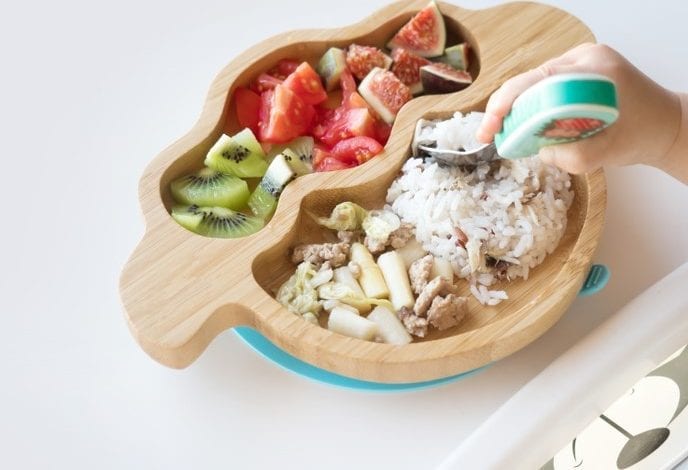

How to Serve Foods 12 months onwards
As your baby gets more confident with finger foods this is a great time to introduce cutlery.
They might throw it straight on the floor at first but persevere and they’ll get the hang of it.
Some older babies prefer stabbing food with a fork rather than scooping it up with a spoon. However they prefer to use them, let your little one lead the way. And keep modelling as you eat with cutlery yourself.
10 Baby Led Weaning First Foods and How to Cut Them
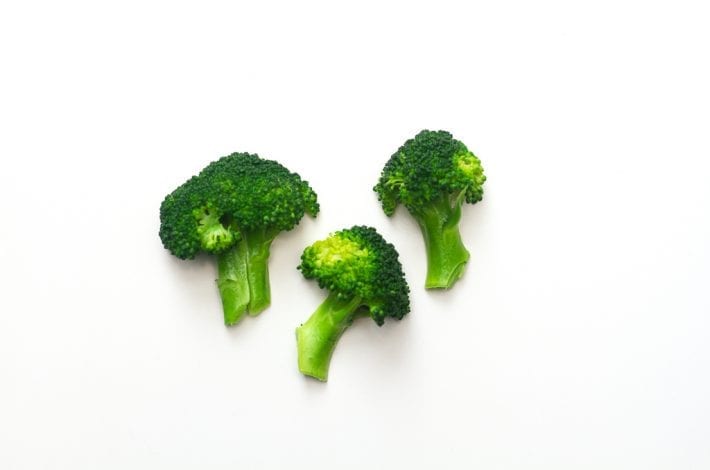

Broccoli
Broccoli is a great finger food.
Cut it into florets and make sure you cook it until it’s soft. If they’re large florets you can slice them down the middle to make them thinner.
Your baby can then grasp the stalk and nibble off the top.
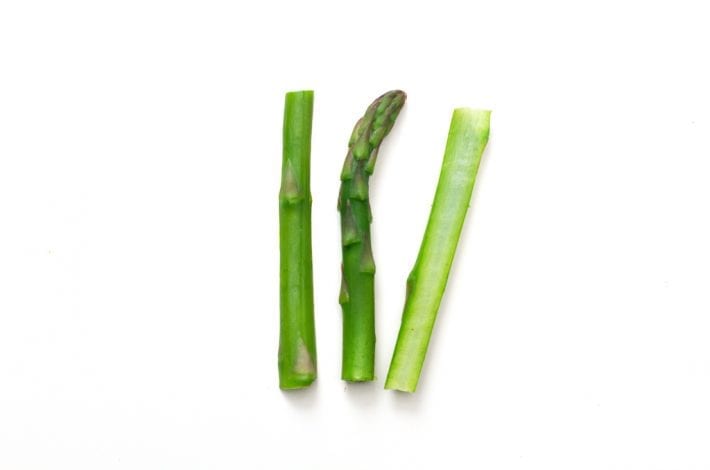

Asparagus
Remove the bottom of the stalks, which are too tough for your baby to chew.
Then cut spears of asparagus in half longways to leave a finger-sized stick for your baby to hold.
You can boil or roast them so they are tender and soft before serving.
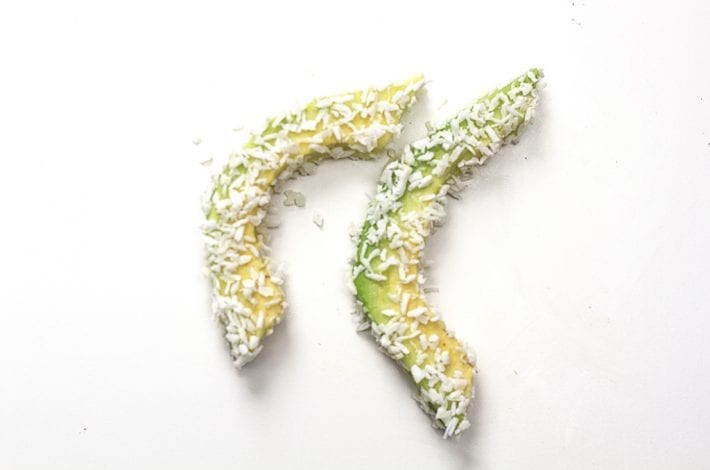

Avocado
Avocado slices are often a favourite with babies.
Cut an avocado in half. Using a sharp knife slice each half into strips while still in the shell. Then scoop the slices out carefully and give the batons to baby.
A great tip on how to service avocado batons is by paediatric registered dietitian Ashley from Veggies & Virtue.
She recommends coating a slice of peeled avocado in desiccated coconut before handing it to your baby. That way it slides and slips a bit less.
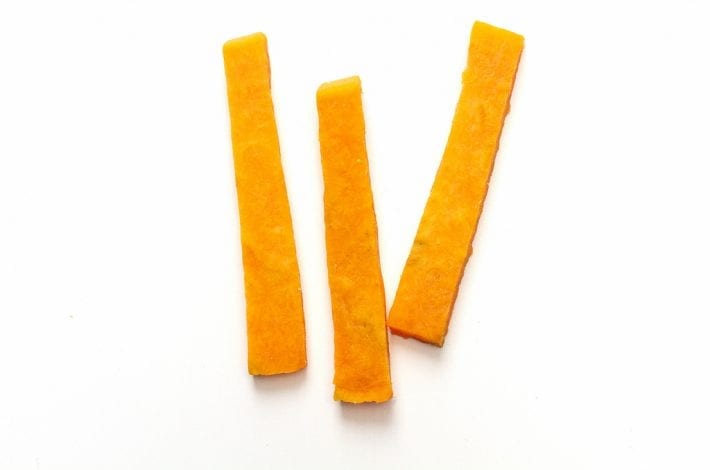

Sweet potato
The natural sweetness of roasted sweet potato is a taste many babies will love.
Peel and cut it into finger sized batons, drizzle with olive oil and roast until it is soft.
If you prefer you can boil or steam it too and add a little coconut oil, or sprinkle with a little ground cinnamon.
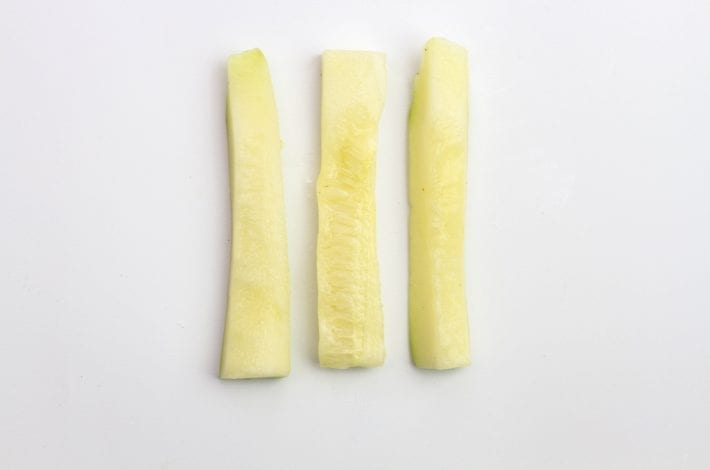

Courgette
Courgette skin can be quite acidic and can irritate some babies’ tummies. For this reason, especially for young babies, we recommend peeling it and then roasting or steaming it in batons. When soft you can offer it to baby as a finger food.
If you find your baby has no problems digesting courgette skin, then you can also steam or roast courgette batons with the skin on. It will then be soft enough for them to mash about with their mouths.
Another nice way to serve courgette is to cut it into little half moons and then steam or roast it in the oven.
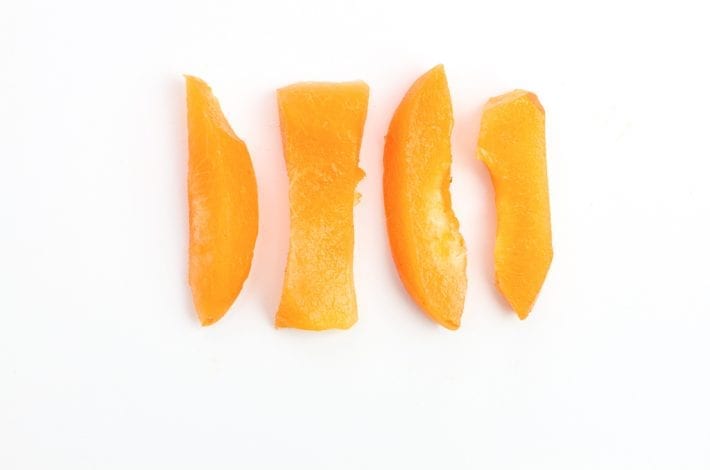

Apricots
Fruits like apricots are too small to cut into finger sized batons.
You can peel them and cut them so that they’re just wide enough for baby to hold in their palm without them falling apart.
Beans and lentils
Cook foods like beans and lentils with some mashed potato or sweet potato until they are soft and then present them in little clumps.
Your baby can hold them in their fist and chew away at them.
If you like you can finely chop and saute some other vegetables like leeks, or butternut squash and add them to the clumps for extra taste.
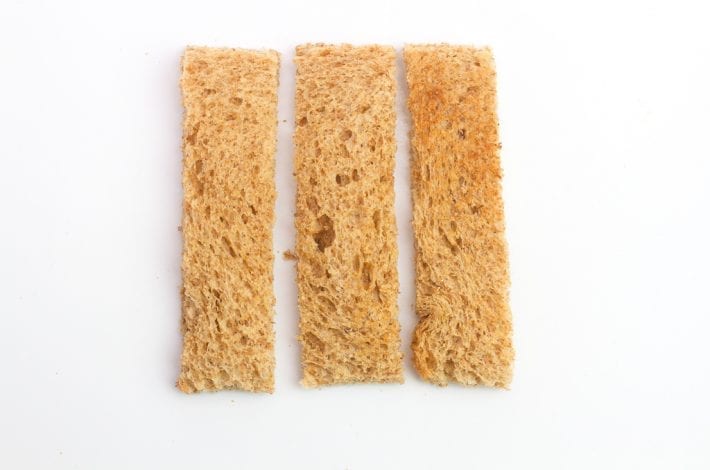

Bread and toast
Toast soldiers are a great first finger food for babies.
They give your baby a new crunchy texture to explore. And they can also be loaded with different toppings to introduce new flavours.
Some ideas for toast spreads are mashed avocado, mashed banana and soft white pasteurised cheese.
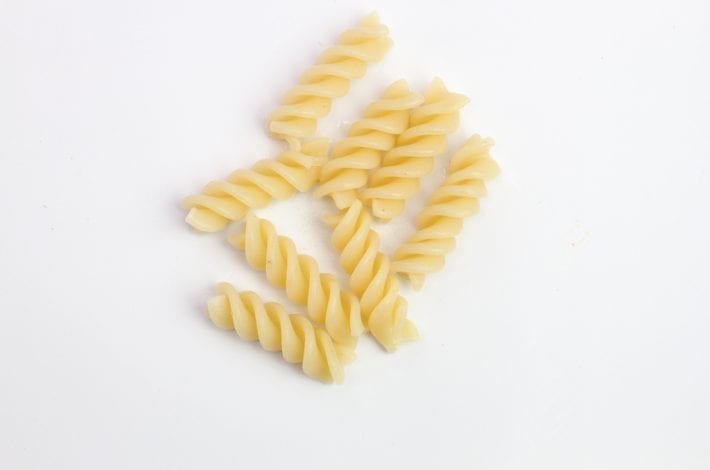

Pasta
When choosing pasta for babies stick to smaller pieces, like spirals or macaroni.
Cook them well so they are soft and break up easily in your baby’s mouth.
Banana
Banana is a great baby led weaning food. Sweet and tasty it also makes a great snack on the go.
One thing to take care of is if baby’s taking large chunks of it in their mouth. As it’s quite thick and sticky, large chunks can stick at the back of their mouths which is a choking concern.
So chop it into thin strips and as with all foods, keep an eye on baby as they are eating.
Kayley from Friendly First Foods shares her tip for serving banana pieces to baby or toddler on the go. This one’s a game-changer!
Foods to avoid when you start baby led weaning
When you start baby led weaning, those hard foods like raw carrot and apple are a no-no.
Little round foods, which could become lodged at the back of baby’s throat (like grapes) should always be chopped into small pieces.
William Dietz co-editor of the American Pediatric Association’s (AAP) Nutrition: What Every Parent Needs to Know, advises parents to avoid giving baby finger foods that are large, sticky or don’t dissolve easily, because they’re potential choking hazards.
There are some foods you should avoid giving baby completely. We’ve listed some of these below:
Foods to not serve to baby:
- whole nuts (these should never be given to a child under 5 years)
- whole grapes
- honey
- salt
- sugar
- marshmallows
- hot dogs
- popcorn
- dried fruits (as they’re difficult to chew)
- hard foods, such as raw carrot or raw apple
- hard, gooey, or sticky candy
- chunks of peanut butter
- raw vegetables
- chewing gum
- undercooked eggs
- undercooked or raw fish or shellfish
- undercooked meats
- bran and high fibre foods (such as All-Bran and muesli)
- mould-ripened and unpasteurised cheese
- pâté
- shark, swordfish or marlin
- cow’s milk (and other animal milks, such as goat milk) as a main drink.
- raw jelly cubes
- ready meals
- processed foods with hydrogenated fats (such as biscuits, crisp, chips and pies)
- caffeine
Gagging can be normal and is not the same as choking
One of the biggest worries parents face when they start baby on solids, is them choking.
Will my baby gag when they start solids with baby led weaning?
Babies might gag when they start eating solids.
They have never eaten food with lumps before. As they learn to work the foods over in their mouths this can lead to a few bumps in the road.
Baby’s gag reflex is nearer the front of their mouth than ours is. When an unfamiliar food or texture gets near their airways, they might make a gagging sound.
Their tongue pushes the food that is unfamiliar back towards the front of their mouth.
When they are gagging (as opposed to choking) they should still be able to breathe easily and carry on eating right after having made the gagging sound.
What does gagging mean?
Gagging might mean they don’t like the taste of that particular food. But it might also mean that they are just learning to accept and chew new textures.
It’s considered to be a normal part of baby led weaning. It can feel worrying to watch your baby gag but, if you stay calm, they often deal with it on their own.
Over time they should improve and gag less.
What is the difference between gagging and choking?
The main difference between gagging and choking is that gagging is loud while choking is silent.
Gagging can involve coughing, loud noises and baby might go a little red. However they should be able to breathe and carry on eating straight afterwards.
Choking is very different from gagging. It happens when a food (or a small object) obstructs the airway.
For that reason choking is silent. If your child is choking they will either make no sound or a very soft or intermittent sound.
How do I know if my baby is choking?
Some signs that baby is choking could be the following:
- gasp for breath
- wave their arms or grab at their throat
- turn blue around the lips and beneath the eyes
- stare with an open mouth while drooling
- make intermittent odd sounds
If you believe your child may be choking, act quickly to give strong thrusts to their back or chest to dislodge anything in their airway. If you want to learn more there is a guide to choking featured below by St John Ambulance.
Useful Resources
What to do if your baby is choking?
If your baby or toddler chokes it is really important to know what to do.
Forewarned is always forearmed. Knowing what to do in the event of an emergency could save your baby’s life.
Video Guides
There are a number of free videos on YouTube that can show you what to do. Make sure they’re made by a trusted provider of First Aid resources.
This short video clip from St John Ambulance gives you a quick guide to back and chest thrusts.
First Aid Articles
St John’s Ambulance also have a detailed article on how to handle baby choking here along with another video and diagrams of what to do.
First Aid Courses
If you want to go one step further then there are a number of First Aid Courses for Babies and Children available. Find one near you.
There are courses you can attend to teach you first aid for babies and young children, including what to do if they choke.
If you’re in the UK you can search the courses the Red Cross offers on their website here to find one near you:
Enjoy the Baby Led Weaning Journey
When your baby starts solids it’s an exciting time – for all of you. It can be messy. Very messy. But it’s lots of fun too.
Follow the safety guides but then relax and enjoy the food adventures right alongside them. Every food will have a new taste, feel and fascination for baby that will make us appreciate the amazing world of food all over again.
Pin it for later
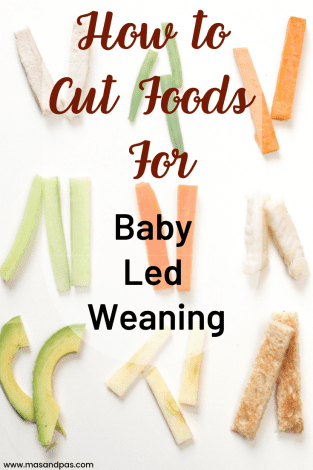

This post may contain some affiliate links. This means that if you click to make a purchase that we may earn a small commission at no extra cost to you.
References
- Statistics on Baby Led Weaning – Annabel Karmel
- Your baby’s first solid foods – NHS
- Foods to avoid giving babies and young children – NHS
- How to cut foods for baby led weaning – Jenna Helwig
- What food size and shape is best for baby? – Little Gourmet Baby
- Choking Hazard Safety’- Nationwide Children’s Org
- Is your baby choking or gagging? – Just the Facts, Baby
- Choking Baby – St John Ambulance
- ‘Broccoli’ – Baby Led Weaning
- BLW: Safe first finger foods – Veggies & Virtue
- Sweet Potato Fingers – Start 4 Life
- Top ten foods for plant-based baby led weaning – Nora Cooks
- Apricots for your baby – BabyFood 101
- Lentils – Baby Led Weaning
- 15 toast ideas for babies and toddlers – Jenna Helwig
- Baby’s First Finger Foods – Parents
- How to cut grapes the right way to avoid baby’s choking – Made for Mums
- The best finger foods for baby – The Bump
- ‘Book first aid and health and safety training courses’ – St John Ambulance
- Foods to Avoid Giving Babies and Young Children, NHS
- What is the difference between gagging and choking – Babycentre


